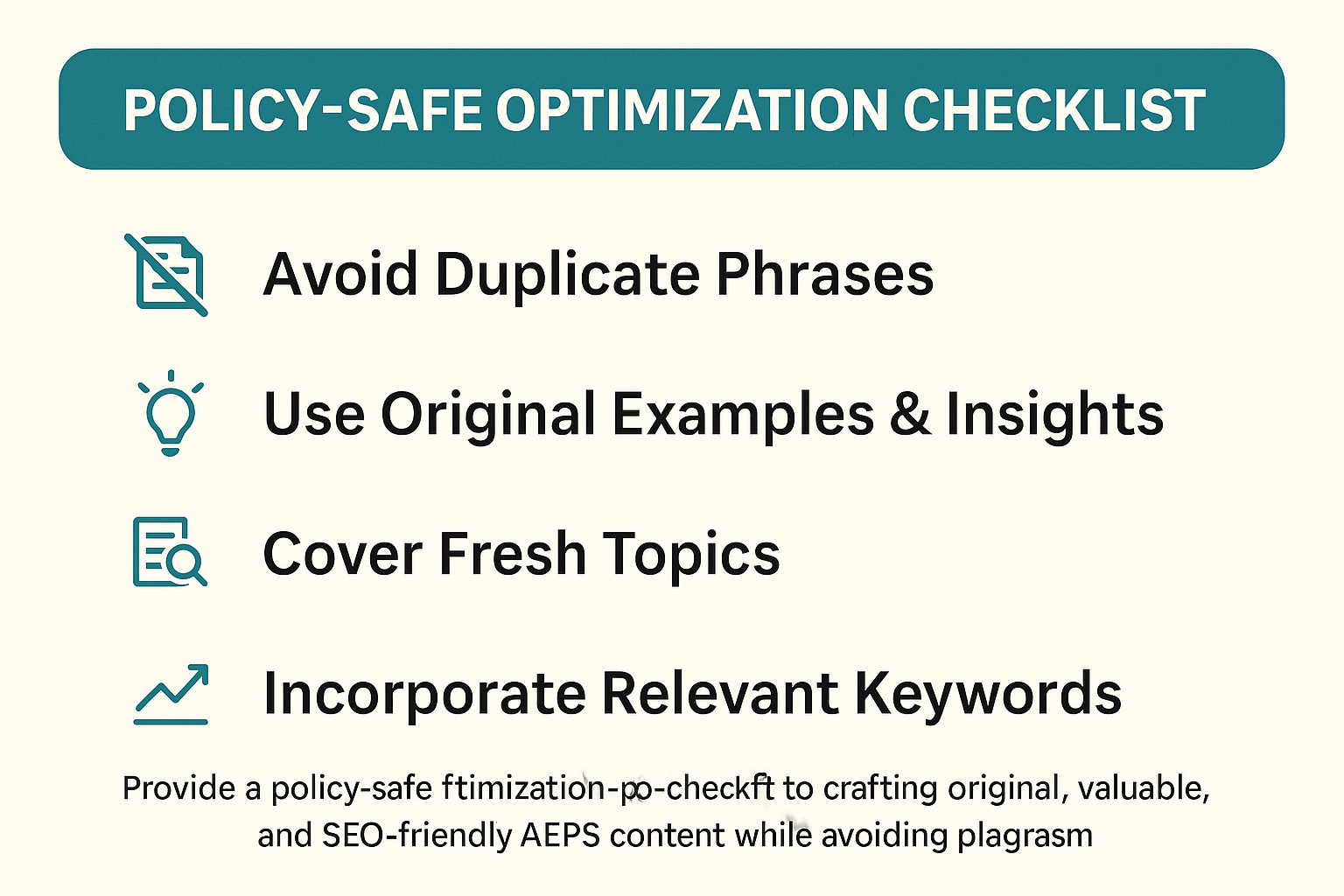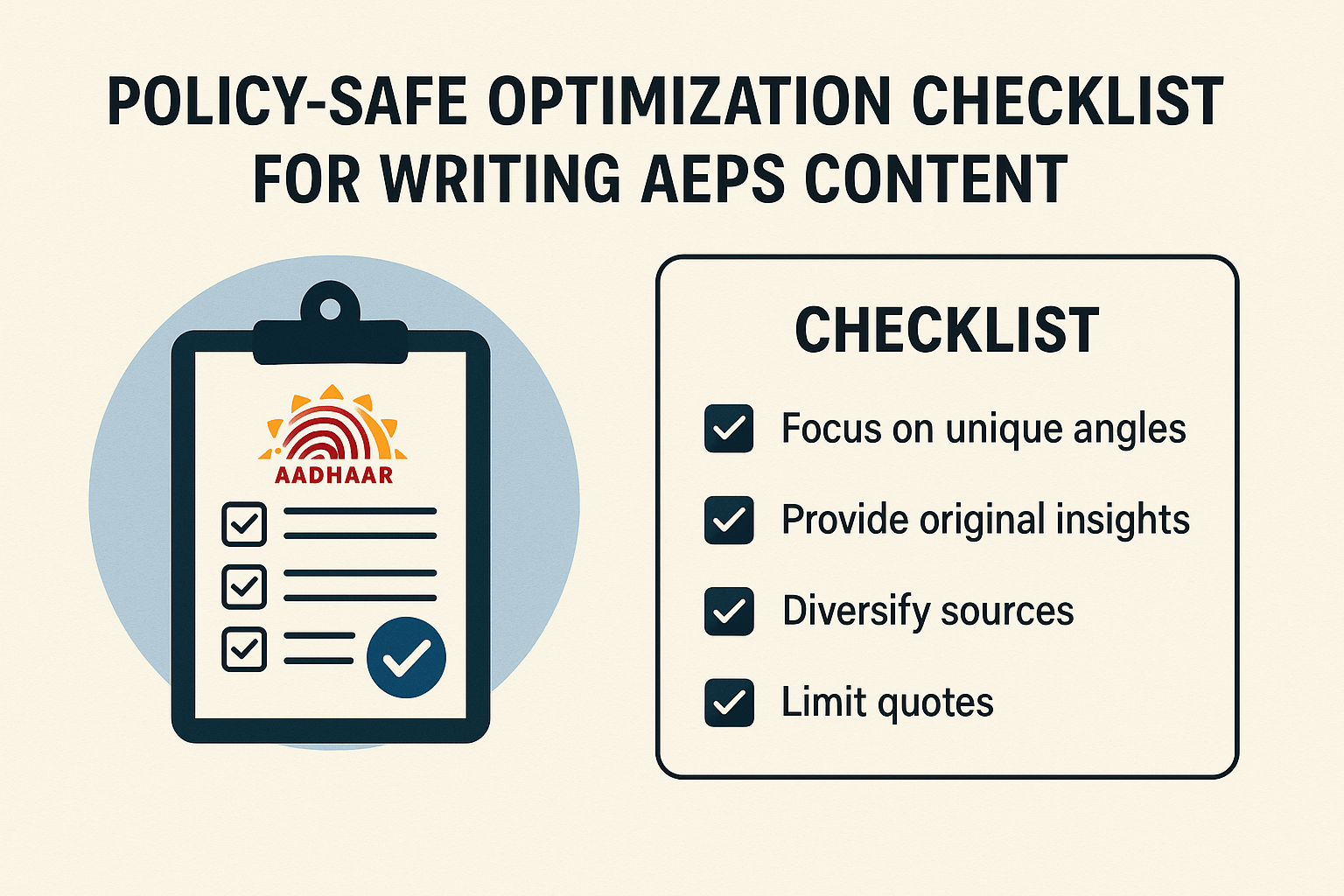Aadhaar Enabled Payment System (AEPS) blogs are in high demand (AEPS Blogs Without Duplicate Content Risk) as (AEPS Blogs Without Duplicate Content Risk) digital transactions grow across India. However, writing about AEPS without triggering duplicate content penalties requires careful strategy. This guide provides a policy-safe optimization checklist to help you craft original, valuable, and SEO-friendly AEPS content while avoiding plagiarism risks.
Why Duplicate Content is a Risk in AEPS Blogging?
Duplicate content occurs when the same or highly similar content appears across multiple web pages. Search engines like Google penalize such content because it offers no unique value to readers. Since AEPS is a regulated financial service, copying content can also lead to legal issues with NPCI (National Payments Corporation of India) or RBI guidelines.
Common Causes of Duplicate AEPS Content
-
Rewriting existing AEPS guides without adding new insights.
-
Copy-pasting technical details from official sources without proper attribution.
-
Publishing repetitive content across multiple websites.

Policy-Safe AEPS Blogging: Optimization Checklist
1. Start with Original Research
Instead of rehashing generic AEPS explanations, conduct fresh research:
-
Interview AEPS service providers or banking experts.
-
Analyze recent RBI updates on AEPS transactions.
-
Use Google Trends to identify trending AEPS queries.
Example: Instead of writing “AEPS allows cash withdrawals,” say “Recent RBI data shows a 30% increase in AEPS cash withdrawals in rural India (2024).”
2. Use a Unique Angle or Case Study
Generic AEPS blogs get lost in search results. Stand out by covering:
-
Success stories (e.g., how AEPS helped farmers during demonetization).
-
Regional adoption trends (e.g., AEPS growth in Kerala vs. Uttar Pradesh).
-
Comparison articles (AEPS vs. UPI: Which is better for rural India?).
3. Write in Your Own Voice
AI-generated or copied content lacks personality. Write conversationally:
❌ “AEPS is a bank-led model enabling Aadhaar-based transactions.”
✅ “Imagine withdrawing cash without your debit card—just your Aadhaar number! That’s AEPS for you.”
4. Properly Cite Official Sources
If quoting NPCI or RBI guidelines, always:
-
Link to the original document.
-
Add your own analysis (e.g., “This new rule means agents must now verify biometrics twice.”).
5. Optimize for SEO Without Keyword Stuffing
-
Focus Keyword Usage: Include “AEPS blogs” naturally (6+ times).
-
Headers & Subheaders: Break content with H2/H3 tags (e.g., “How AEPS Reduces Fraud Risks”).
-
Internal Links: Link to related posts (e.g., “How to Register for AEPS Services”).
-
External Links: Reference authoritative sources like NPCI’s official site.
6. Add Visuals & Media
-
Infographics explaining AEPS transaction flow.
-
Videos demonstrating AEPS biometric authentication.
-
Screenshots of AEPS error fixes (with alt text: “AEPS transaction failed? Try these fixes”).
7. Update Older AEPS Content
Google favors fresh information. Revisit old posts and:
-
Add 2024 AEPS transaction limits.
-
Clarify new RBI mandates.
-
Include user-submitted FAQs.

Frequently Asked Questions (FAQs)
1. Can I copy AEPS details from the NPCI website?
No. Instead, paraphrase and cite NPCI as the source. Example:
-
❌ “AEPS requires Aadhaar linking.” (Copied)
-
✅ “As per NPCI’s 2024 guidelines, users must link Aadhaar to their bank for AEPS.” (Original + Cited)
2. How often should I update my AEPS blog?
Every 6 months, or whenever RBI/NPCI announces updates.
3. Does Google penalize similar AEPS content?
Yes, if it lacks unique value. Always add new data, expert quotes, or case studies.
Conclusion
Writing unique AEPS blogs requires more than rewording existing content. By following this policy-safe optimization checklist, you can create original, engaging, and compliant AEPS articles that rank well without duplication risks. Focus on fresh insights, proper citations, and reader-friendly formatting to stand out in the competitive fintech niche.
Disclaimer: This post is for educational purposes only. If you have any concerns regarding content ownership or copyright issues, please refer to our DMCA policy for takedown requests. Always verify AEPS-related information with official RBI/NPCI sources before implementation.
